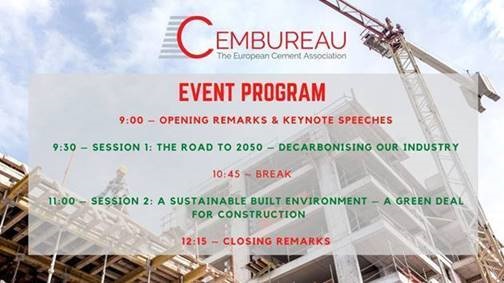Adapting to the current times and to all the issues that are setting this century, Cembureau has organised the next summit on 13 October 2020 with a single objective: to promote an European green agreement. To celebrate the Europe of the future: to build a green agreement. This is called this summit which will focus on the 2050 carbon neutrality roadmap and how cement and concrete, together with the construction industry, will help to build this agreement. Due to current restrictions marked by the COVID-19, the act will be performed virtually through the Zoom web seminar. For this reason, the scheduled schedules have been adapted. If you want to participate, register on this link.
The training of confirmed reports includes:
- Raoul de Parisot, president of CEMBUREAU
- Jochen Flasbarth, German Secretary of State at the Ministry of the Environment, Conservation of Nature and Nuclear Safety
- Arthur Runge-Metzger, director of climate strategy, governance and emissions, DG Climate Action
- Kęstutis Sadauskas, director of green economy, DG Environment
- Maria da Graça Carvalho, eurodeputy
- Maria Spyraki, eurodeputy
- For Klevnäs, partner, material economy
- Judith Kirton-Darling, Deputy Secretary-General, Industriell
- Mechthild Wörsdörfer, sustainability director of IE
- Laury Barnes-Davin, head of research Fastcarb
- Jon Morrish, CEO of Western and Southern Europe, HeidelbergCement
- Magali Anderson, sustainability director LafargeHolcim.
The day will be divided into two sessions. The first is entitled The Road to 2050: decarbonising our industry. It is going to focus on the contribution of the cement industry to reducing CO2 emissions in the manufacture of clínquer and cement, the first two ‘C’s’ of decarbonization strategy. In addition, current efforts to decarbonise the cement sector in terms of innovation and the deployment of low-carbon technologies will be analysed, and the development of appropriate policy frameworks to carry out these investments. This will include a number of key policy issues, such as access to alternative fuels and renewable energy, the development of innovative and public private financing tools for innovative technologies, as well as stable long-term regulatory frameworks to support industrial transformation. The debate on the carbon border mechanisms will also be part of this session.
The second part of the act is entitled A Sustainable Built Environment: An Environmental Agreement for Construction. It is going to focus on the later cement market and thus on the other three “C”: concrete-construction-carbonation. The political initiatives to create a sustainable built environment in Europe will be discussed, as will the contribution of the cement and concrete industry in this regard. Legislation under the Green Deal will be analysed with a specific link to existing and planned political initiatives such as the Circular Economic Action Plan, the Construction Level Initiative, the implementation of the Energy Performance Directive in buildings, the Construction Products Regulation and the next Wave of Renovation for Europe.

